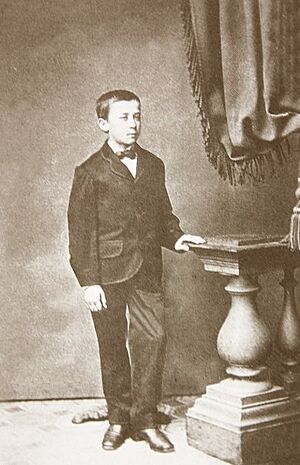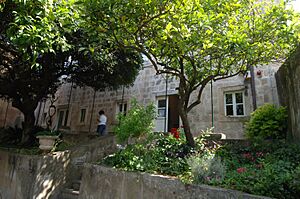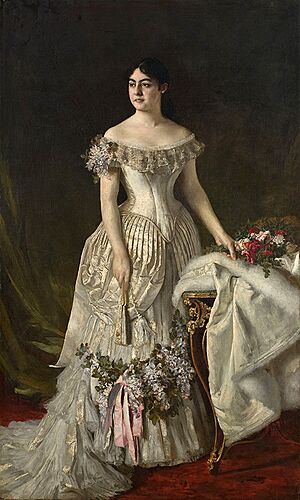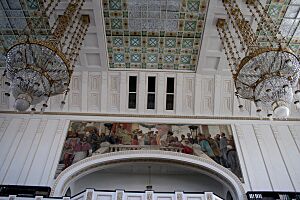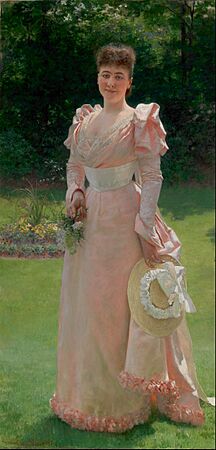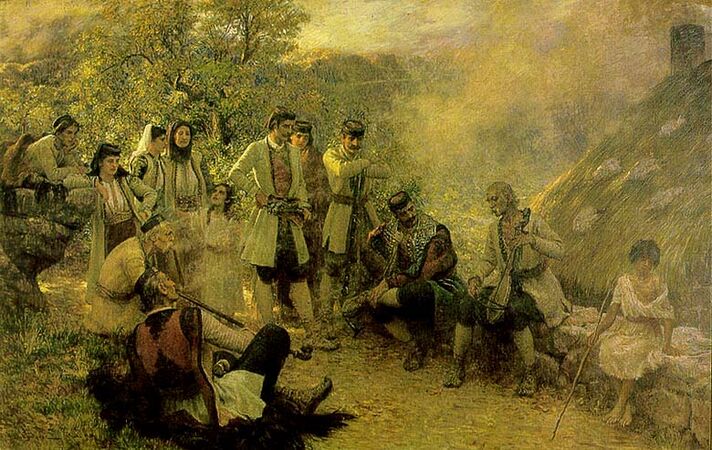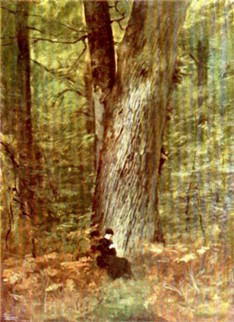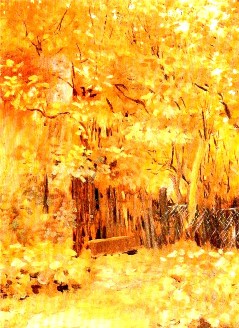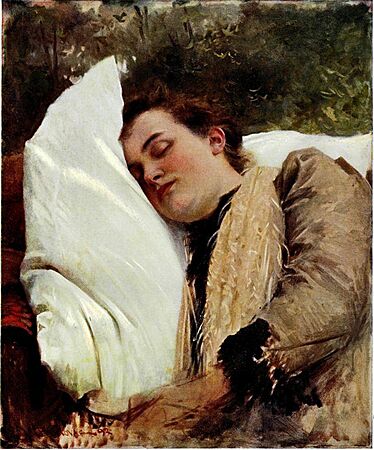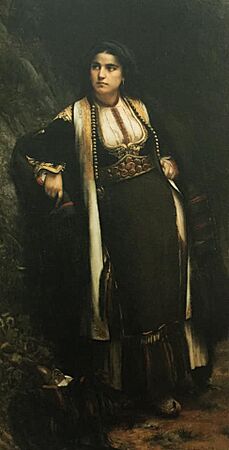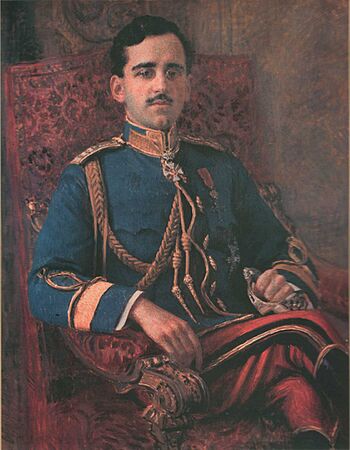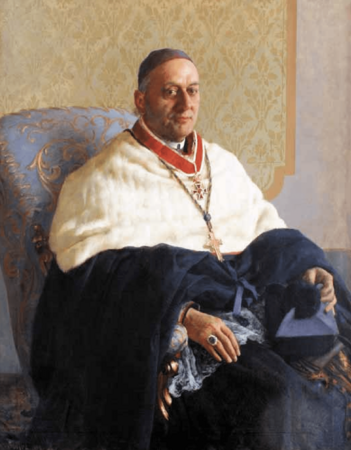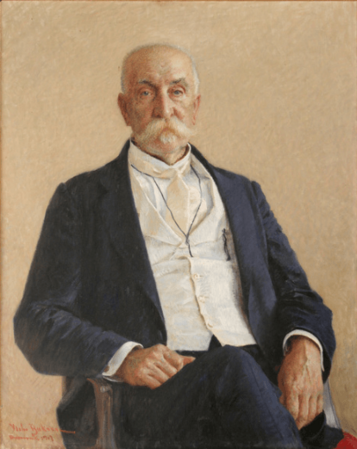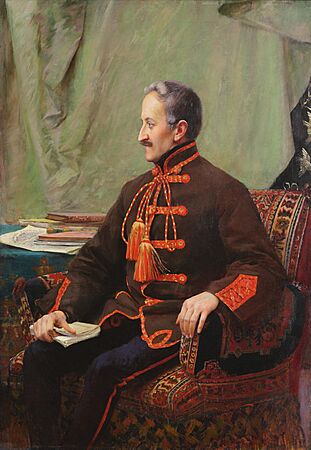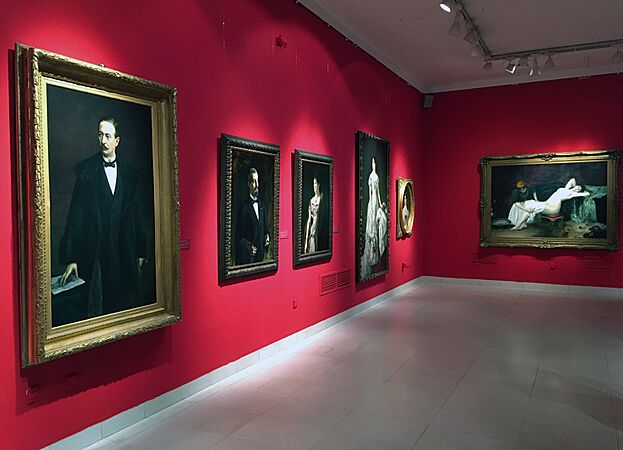Vlaho Bukovac facts for kids
Quick facts for kids
Vlaho Bukovac
|
|
|---|---|
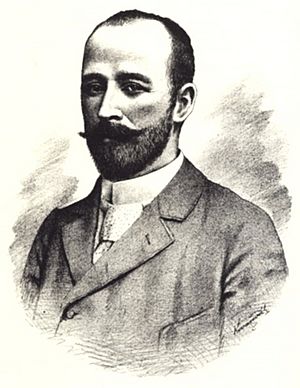 |
|
| Born |
Biagio Faggioni
4 July 1855 |
| Died | 23 April 1922 (aged 66) |
| Known for | Painting |
|
Notable work
|
Une fleur Natalie of Serbia Curtain for Croatian National Theatre of Zagreb |
Vlaho Bukovac (born Biagio Faggioni; July 4, 1855 – April 23, 1922) was a famous painter from Croatia. His life and art were very varied, meaning he worked in many different places and his painting style changed a lot over time.
He is well-known for his 1887 painting called Une fleur (which means A Flower). He created this painting when he was living in France. It became quite famous and was talked about in many art reviews back then. Bukovac was also a special painter for royal families, like the Obrenović dynasty, Karađorđević dynasty, and Petrović-Njegoš dynasty. In Zagreb, he is most famous for painting the large theatre curtain at the Croatian National Theatre in Zagreb in 1895.
Contents
Biography: The Life of Vlaho Bukovac
Vlaho Bukovac was born as Biagio Faggioni in a town called Cavtat. This town is south of Dubrovnik in a region called Dalmatia. His mother was Croatian. His father's side of the family came from Italy. His grandfather was an Italian sailor whose ship crashed near Cavtat. He met a local girl, Ana Kličan, who became Bukovac's grandmother. They got married and settled in Cavtat.
When Bukovac was eleven, he went with his uncle Frano to New York City. He lived there for four years before coming back home to his parents. Soon after, he started working as a sailor. He traveled on routes that went to Istanbul, Liverpool, and Odessa. However, his sailing career ended quickly. He got hurt after falling on the ship. While he was recovering at home, he started to paint. In 1873, he and his brother Jozo went to Peru. He lived there for a year, selling his paintings. Then, in 1874, he moved to California.
In San Francisco, he began painting as a hobby. He also took his first art lessons from a teacher named Domenico Tojetti. He painted many portraits, including several for the family of a rich businessman, William Dunphy.
In 1877, Faggioni returned to Europe to study painting. Around this time, he started using the last name Bukovac. This name is a Croatian translation of the Italian word faggio, which means "beech tree." He studied art in Paris. He received financial help from people who supported artists, like Josip Juraj Strossmayer and Medo Pucić. He became a student at the famous École des Beaux-Arts in Paris. There, he learned from the well-known French artist Alexandre Cabanel. A Serb trader from Dubrovnik, Petar Marić, also helped him with money. Bukovac later painted a portrait of Marić and his family.
In 1892, he married Jelica Pitarević from Dubrovnik. They had one son and three daughters. He became a special member of the Czech Academy of Sciences. He was also an honorary member of the Yugoslav Academy of Sciences and Arts (JAZU). Later, he joined the Serbian Royal Academy. He passed away in Prague, where he had studied and taught art.
Early Career: Painting in France and England
Bukovac started his painting career in France. He painted in a very smooth and realistic style. His popular paintings became very successful at the Paris Salon, which was a big art exhibition. While in France, he often traveled to England and the Dalmatian coast, where he was born.
From the mid-1880s until World War I, he regularly visited England. Many of his paintings were sold there by art dealers called Vicars Brothers. One famous painting was The White Slave in 1884. In England, Bukovac gained support from important people like Samson Fox and Richard LeDoux. Their help made him more famous in British society and the art world. Samson Fox bought a painting called Suffer the Little Children to Come to Me. This painting was shown at the Paris Salon in 1888. Later, it was given to St. Robert's Church in Harrogate.
Working for Royal Families in Serbia and Montenegro
Bukovac was the official painter for the Obrenović dynasty and Karađorđević dynasty royal families in Serbia. He painted a portrait of Natalie of Serbia. For this work, he received an award called the Order of the Cross of Takovo. He also received the Order of St. Sava.
Bukovac visited Kingdom of Montenegro several times. He painted members of the Petrović-Njegoš dynasty and other important people there. He was given the Order of Prince Danilo I for his art. Some of his paintings are now part of the collection at the Museum of Fine Arts of Montenegro.
Time in Croatia and Prague
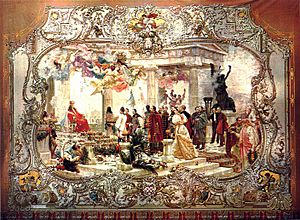
Bukovac became a very important artist in Zagreb, Croatia, from 1893 to 1897. He brought new French art ideas with him. These new ideas were most clear in his landscapes. He started using bright and lighter colors. He painted with free, soft brushstrokes and added more light to his paintings. Some of his works can be seen in the Golden Hall of a palace on Opatička Street. This building is now the Croatian Institute of History. Here, other Croatian artists were asked to paint historical scenes.
In 1895, Bukovac finished one of his most famous works. It was a large theatre curtain for the Croatian National Theatre in Zagreb. The curtain was called The Reformation of Croatian Literature and Art. During his time in Zagreb, he led many important cultural and art events. In December 1893, Bukovac and Izidor Kršnjavi opened an exhibition called "Croatian Salon." It showed the works of many top Croatian artists.
A few years later, Bukovac had his home and art studio built. In 1895, he started the "Croatian Society of Artists" and became its first president. Only Croatian artists who had shown their work successfully at three different exhibitions could join. The first members included well-known artists like Oskar Alexander and Menci Clement Crnčić.
As president of the Croatian Society of Artists, he helped open the beautiful new Art Pavilion in Zagreb in December 1898. He gave a speech, thanking the city for building the pavilion for Croatian artists. During this time, he felt very happy and excited in Zagreb. He spent a lot of time helping his new students. One of them was the famous Croatian painter Mirko Rački. However, because of some disagreements, he went back to his hometown of Cavtat. He stayed there from 1898 to 1902.
In 1903, he moved to Prague. There, he became a professor at the Academy of Fine Arts in Prague. He introduced a painting style called pointillism to the Prague Academy. He became known as an excellent teacher.
In 1908, he was chosen as president of another art group in Split. From 1912 to 1913, Bukovac painted "Development of Croatian Culture." This painting is in the main reading room of the Croatian State Archives. In 1918, he published his autobiography, "My Life," in Zagreb.
Legacy: Bukovac's Impact on Art
Vlaho Bukovac was an artist who followed both traditional art rules and his own creative ideas. A new art style called Impressionism developed in Paris in the 1870s. This style focused on free artistic expression. Bukovac understood both the old, formal art rules and the new freedom of Impressionism. He accepted these modern ideas. He painted casual pictures using free brushstrokes and a technique called pointillist, where he used small dots of color.
His childhood home in Cavtat has been turned into a museum called the Bukovac House. It is part of the Museums and Galleries of Konavle. The museum has a large collection of Bukovac’s artworks. These include portraits and paintings from his time in Paris, Zagreb, Cavtat, and Prague.
Besides his artwork, the museum also has many of Bukovac's personal items. These include sketches, private letters, photographs, and the original handwritten copy of his autobiography, "My Life." This book was published in 1918. You can also find Bukovac's work in the collection of Milan Jovanović Stojimirović. He gave many paintings, sketches, and other items to the Art Department of the Museum in Smederevo.
Gallery
-
Gundulić's Dream (1894)
See also
 In Spanish: Vlaho Bukovac para niños
In Spanish: Vlaho Bukovac para niños


